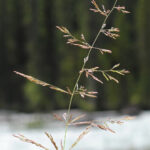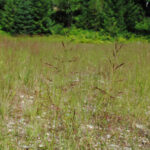Redtop
Agrostis gigantea
General Description
Redtop is a long-lived, perennial tufted grass with common names like bentgrass or ticklegrass. Several closely related species of this bentgrass group are discussed in the literature including redtop (Agrostis gigantea Roth or Agrostis stolonifera – introduced), and hair bentgrass (Agrostis scabra – native). The common name ticklegrass can refer to any of these species. Redtop was introduced and has become naturalized throughout British Columbia. It is abundant following disturbance, especially in the northeastern part of British Columbia.
Type
Tame grass.
Origin
Introduced from Europe.
Longevity
High.
Use
Reclamation. Introduced initially for use in lawns and turf grasses. Used for erosion control in riparian areas and wetlands, and rehabilitation of disturbed sites with high acidity or heavy metal contamination. There has been some use for pasture and hay in higher elevation wet meadows in western states.
Optimal Time of Use
Spring and summer.
Recovery After Use
Tolerant of grazing because of semi-prostrate growth and generally low palatability.
Low.
Palatability/Nutritional Value
Cattle prefer most other tame grass species over redtop. When it is available it is preferred by cattle and horses in spring and summer, preferred by sheep in spring, and desirable in summer.
Annual Precipitation min/max (mm)
450mm / 600mm
Drought Tolerance
Moderate tolerance.
Flooding Tolerance
Redtop is adapted to frequent flooding.
Winter Hardiness
Redtop has a high cold tolerance and is adapted to northern areas of North America.
Soil Texture Preference
Grows well on poor, clayey soils, on poorly drained soil, and on soils with low fertility. Not suited to limestone-based soils.
Erosion Control
Rhizomatous root system makes this species useful for erosion control.
Salinity Tolerance
Low salinity tolerance.
Acidity Tolerance
High tolerance. Redtop grows well on very acid soils and will tolerate pH as low as 4.5.
Alkalinity Tolerance
Low tolerance- up to pH 8.0.
Seeds per kg
10,670,000 seeds/kg (4,839,836 seeds/lb)
Suggested Mixtures
Redtop is seldom seeded alone and forage quality is improved when seeded with species such as timothy and/or clover species.
Ease of Establishment
When established from seed, redtop plants can have low vigour resulting in poor stands. However, once established plants will readily spread. Early spring seeding is recommended to allow establishment before onset of drier conditions. Broadcast seeding with light harrowing is suitable. Soil compaction over seed may cause crusting which can be impenetrable to emerging seedlings.
Competitiveness
Can be highly competitive and invasive in some regions and habitats.
Management Considerations
This species should not be seeded where native vegetation is desired, and readily hybridizes with other Agrostis species. Pasture mixes will need to be grazed closely to allow for palatable regrowth on wetter and sub-irrigated sites.
BC Rangeland Seeding Manual, USDA Plants Database
Redtop is naturalized throughout BC, and is adapted to all zones in the region except semi-arid parts of the Bunchgrass zone. It should not be seeded where native plant communities are desired.
Redtop is naturalized throughout BC, and is adapted to all zones in the region except semi-arid parts of the Bunchgrass zone. It should not be seeded where native plant communities are desired.
Redtop is naturalized throughout BC and adapted to the Peace-Liard region. It should not be seeded where native plant communities are desired.

